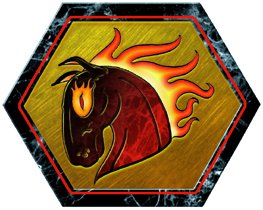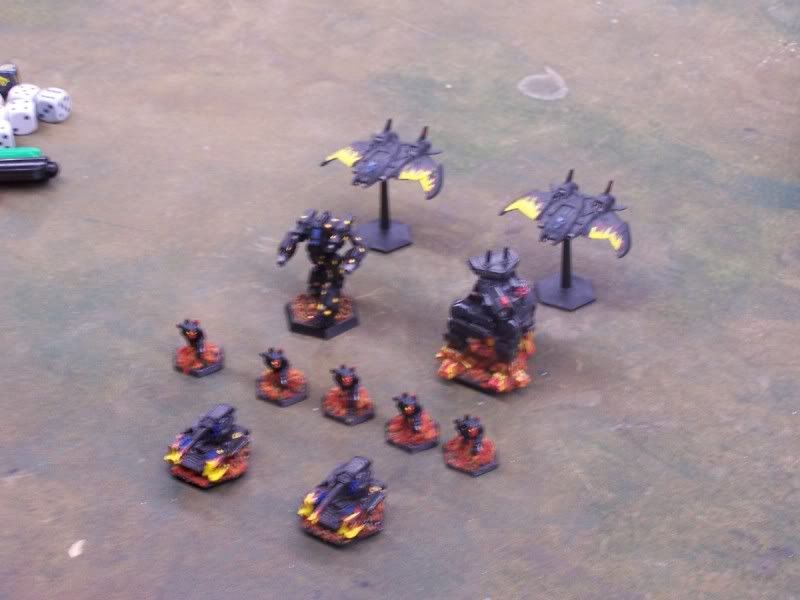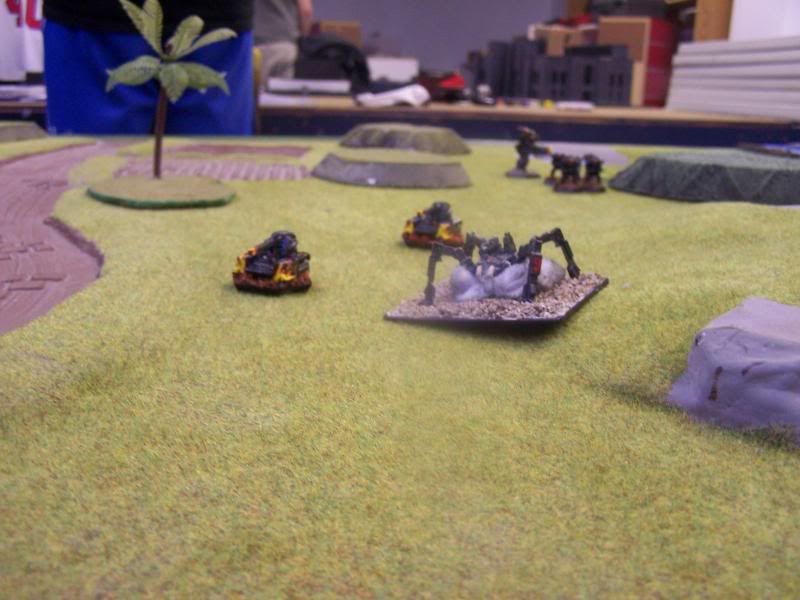Clan Hell's Horses
 Clan Hell's Horses
Clan Hell's Horses is one of the original twenty
Clans founded by
Nicholas Kerensky, named for the
Hell's Horses genetically engineered for the highland deserts of
Circe. The Clan lives by the motto that "man comes before machine," a philosophy which values the individual soldier over whichever tool of warfare he uses. While this philosophy has resulted in some battlefield practices unique among the Clans, it also permeates other aspects of Clan Hell's Horses, such that all Clan members are treated as an integral part of the greater whole, regardless of their birth. Clan Hell's Horses are also famous for giving birth to what would become
Elementals, genetically modified super-soldiers who have formed an important part of Clan warfare since their introduction. Despite being lead by
Crusaders the Clan did not take part in
Operation Revival, though it managed to secure a number of
Inner Sphere worlds in its aftermath.
History
Founding
Clan Hell's Horses was founded by
Lieutenant General John Fletcher, commander of the
35th Infantry Division of the
Star League Defense Force. General Fletcher, a staunch loyalist of General
Aleksandr Kerensky, took part in the invasion to
liberate Terra from
Stefan Amaris during the
Amaris Civil War. Fletcher's loyalty to Kerensky and the ideals of the
Star League would inspire him to join the
First Exodus from the Inner Sphere in the wake of that terrible conflict and settle on the
Pentagon Worlds to start anew.
However old divisions among the population soon festered into a new
civil war, and despite gathering together like-mind soldiers to restore order in Kerensky's name Fletcher was unable to prevent the outbreak of warfare. When Kerensky died Fletcher accompanied his son,
Nicholas Kerensky, on the
Second Exodus to the
Kerensky Cluster where the Clans were formed.
For his loyalty Fletcher was made
Khan of Clan Hell's Horses, and he chose
Colonel Patricia Cobb, one of his most able 'Mech
battalion commanders from the Thirty-fifth, as his
saKhan. Together they forged their Clan into one which placed its focus first and foremost on its warriors. For this reason they requested a smaller share of
BattleMech forces in return for a larger share of
conventional armor and approval to train additional
infantry from decommissioned
WarShip crews. In short order they were able to put together an impressive combined-arms army, bucking current military orthodoxy that saw the 'Mech as the supreme battlefield weapon. While their critics foresaw the Clan's demise, the Hell's Horses' performance would eventually cast aside the myth of 'Mech dominance.
Operation Klondike
During the trials for participating in the coveted
Eden invasion part of
Operation Klondike, the Hell's Horses won a surprise victory over
Clan Ghost Bear. For the most part the Horses were assigned auxiliary or rear-area duties, until Khan Fletcher convinced Nicholas to assign his Clan an independent operation, the conquest of the
Purgatory Peninsula. The peninsula, located in the western part of the continent of
Irkutsk, was home to a collection of city-states locked in conflict. Of the city-states, the most important ones were Allah, Dante and Vesta.
While the city-states were no friends of each other, they did unite against the invaders and put together a combined force which outnumbered the Hell's Horses six to one. After suffering from a series of ambushes that destroyed several Clan scout 'Mechs, Fletcher began looking for flaws in the enemy's strategy and realized that they fixated on targeting 'Mechs above "inferior" tanks and infantry. He put this knowledge to good use in the Clan's counter-insurgency strategy by using their 'Mechs as bait to draw out the rebels so they could be smashed by conventional forces. By the end of the two-week campaign the Hell's Horses had completely smashed all resistance on the peninsula, proving the success of their unorthodox tactics and suffering fewer equipment losses than other Clans which preferred to slug it out 'Mech-to-'Mech. Vesta, the largest and last city to fall, would be renamed Hades and transformed into the Hell's Horses' capital.
Golden Century
Their peculiar philosophy led most of the other Clans to dismiss them. The Hell's Horses tended to keep to themselves until the development of the
Elemental infantry armor by
Clan Wolf. Eager to obtain the Elemental armor, the Hell's Horses entered a series of trials with Clan Wolf where the armor was put up against the infantry breeding protocols that the Hell's Horses had developed. These gigantic warriors would be known as
'Elementals'
The Hell's Horses won one of the three trials and so obtained the Elemental armor. Other Clans challenged the Hell's Horses for the breeding rights, among them
Clan Fire Mandrill. In
2870,
Kindraa Smythe-Jewel of the Fire Mandrills used deceptive bidding tactics to give the impression of a much smaller force and won the trial. Kindraa Payne would take the brunt of the Trial of Possession, while the Smythe-Jewels walked away with new Elemental breeding protocols and Battle Armor. The Horse's Khan
Eric Amirault demanded a
Trial of Annihilation but was denied by a Grand Council vote. As the Hell's Horses prepared to move against the Fire Mandrills,
Clan Coyote's Khan
Manfred Hollifield stepped in. They too had been cheated by
Kindraa Smythe-Jewel in their bid for the
OmniMech a few years prior.
Seeing the wisdom in joining together, the Hell's Horses arranged for a contract bid to include the Coyotes in the Hell's Horses trial against the Kindraa. The combined Hell's Horses-Coyote task force descended on the Smythe-Jewel enclave on
Foster and challenged them to a Trial that saw the death of the
Kindraa Smythe-Jewel. Half the genetic legacies and most of the battle salvage was taken by the Horses and the Coyotes took the enclave, the bondsmen, and the rest of the legacies, with small shares of each going to
Kindraa Payne, which had joined in the final stages of the battle, trapping the last Smythe-Jewels as they attempted to flee. The Clans each parted with great respect for one another. This action did much to win the Hell's Horses a good measure of respect from the rest of the Clans as well.
For a time it looked as though the Hell's Horses might shift away from their combined-arms, heavy reliance on vehicle philosophy and more towards the use of BattleMechs. But all that changed when 'Mechworks Alpha on
Tokasha, their primary 'Mech factory, was targeted by
Clan Ghost Bear during a
Trial of Possession. The Horses bid an entire Galaxy in its defense which the Bears matched. It was a fierce, pitched battle but seemed to favor the Hell's Horses until a stray shot slew the beloved Ghost Bear
Khan Kilbourne Jorgensson. The outraged Ghost Bears tore into the Hell's Horses in a berserk fury, forcing them to withdraw.
Pre-Invasion
The loss of Metal Works Alpha and Kilbourne Jorgensson sparked a fierce feud between the Hell's Horses and Ghost Bears. When the Ghost Bears launched a Trial of Possession for Industriplex Alpha on
Niles (Clan planet), the Hell's Horses' homeworld, another fierce battle ensued. Though the Horses emerged victorious they lost their Khan,
Lair Seidman. He was replaced by
Malavai Fletcher, an Elemental who was horribly injured in that battle.
Fletcher, a staunch
Crusader, managed to appoint enough Crusaders in his
Clan to leadership positions to push the Horses into the Crusader camp, despite the fact that many among the Horses' rank and file were Wardens. This political shift helped to make
Operation Revival a reality after
Comstar's
Outbound Light appeared over the
Smoke Jaguar world of
Huntress in
3048. The Horses would be eliminated from the invasion early on, but this did not bother Khan Fletcher too much. His leadership during the invasion years kept his Clan out of much of the infighting in the
Clan Homeworlds, instead keeping them focused on building their strength.
The Invasion
When
Clan Ice Hellion's Khan
Asa Taney formed his Home Clan Coalition in the wake of
Tukayyid, Khan Fletcher stood by him, supporting the effort to renew the invasion. Though they would not get the invasion they wanted, the
Harvest Trials presented their own opportunity.
Though the Horses did not win a place in the invasion, they did manage to find a way to obtain worlds in the
Inner Sphere. When Khan
Vladimir Ward of the Wolves started the
Harvest Trials, Khan Fletcher convinced him to bid Hell's Horses units in contract bids (much as the Hell's Horses had done with the Coyotes) without first winning those units to the Wolves. Khan Ward agreed and ceded three worlds in the Clan Wolf Occupation Zone:
Stanzach,
Vorarlberg, and
Engadin to Clan Hell's Horses.
During the
Great Refusal on
Strana Mechty, the Hell's Horses fought against and lost to the
Free Rasalhague Republic's
Third Drakøns.
During the numerous Trials of Possession that were launched following the Annihilation of the
Smoke Jaguars, Abjuration of the
Nova Cats, and relocation of the Ghost Bears, the Hell's Horses have managed to seize large portions of
Bearclaw,
Hoard, and
Tokasha, pitting them against forces from the
Jade Falcons,
Ice Hellions, and
Snow Ravens. The Horses also managed to seize the last portion of
Kirin making it an exclusive Hells' Horses possession.
Not long afterwards the Horses raided the Ghost Bear Occupation Zone (renamed the
Ghost Bear Dominion) while the Ghost Bears were at war with the
Draconis Combine. However, after the war with the Combine ended, the Bears retaliated and seized all three of the Hell's Horses worlds, sending them back to Clan Space. Khan Malavai Fletcher's leadership was challenged and he was slain by James Cobb, a Warden, who assumed the Khanship.
After a tentative peace with the Ghost Bears, the Hell's Horses launched a successful invasion of Wolf and Clan Jade Falcon Occupation Zones, making their capital on
Csesztreg. Their plan to transplant their entire population, much like the Ghost Bear's shift, was discovered and eventually led to the
Clan Civil War that separated the Inner Sphere Clans from their homeworld brethren.
Jihad Era
No Data.
Post-Jihad Era
The Horses found themselves facing a number of problems in the wake of the
Jihad. While the clan was buoyant following their successes and enjoyed a touman larger than that of the Wolves and broadly comparable in size to that of the Falcons, their warriors were heavily committed. Internally, elements of both the intelligence organization
Mimir and the
Motstånd terrorist network continued to make life difficult for the Horses domestically, while the Rasalhagian population of the
Ghost Bear Dominion continued to press
Clan Ghost Bear to attack the Horse occupation zone and reclaim ethnically Rasalhagian worlds. Adding to the external threat from the Ghost Bears was the desire on the part of the Jade Falcons to reclaim the worlds that the Horses had opportunistically snatched during the incursion into the Falcon occupation zone by the
Ice Hellions.
Wars of Reaving
No Data.
Culture
Clan Hell's Horses' philosophy of valuing the individual's role in the greater whole permeates all levels of society. While caste and birth prejudice still exists within the Clan, it is kept in check by ongoing efforts which extol cooperation among and within all Clan castes. This unity extends from the lowliest laborer toiling in the factories to the Khans themselves, and none are held in less esteem than is earned. Even
freeborns and
solahma warriors are given respect where other Clans would tolerate or mistreat them; only
dezgra warriors are exempt from this rule.
Politicking is mostly shunned by the Hell's Horses, even at the
Grand Council level where the Khans see their duty in leading their Clan more important than backroom bargaining. As far as Clansmen go the Hell's Horses are seen as docile and unswervingly obedient to the chain of command, making their Clan far more stable than others where internal power plays are the norm, though this lack of personal initiative has hampered their efforts to expand beyond their already-considerable homeworld enclaves. Their use of contract warfare, allowing warriors of different units or even Clans to include each others' forces in a single bid, would seem to run counter to this idea, however the Hell's Horses view it as a strategic matter to ensure victories that go beyond the Clan's own concerns.
Military
Main article: Clan Hell's Horses Touman
Quote

Hell's Horses Warrior with tank
Clan Hell's Horses incorporate a number of unique features into their military doctrine which sets them apart from other Clans, most notably their use of conventional
infantry and
armor even in front-line units. Their model of combined-arms warfare means roughly two-thirds of all 'Mech
Stars are part of a
Nova formation, while all vehicle Stars contain an equal number of infantry
Points. As a result their
touman numbers fewer 'Mechs than normal but make up for it in a disproportionate amount of infantry and support.
The Clan is also unique for instituting the official ranks of
Nova Commander and
Nova Captain to command Novas and
Supernovas. The existence of such ranks also means more positions for warriors to fight over in a
Trial of Position and means many more warriors are found in the middle ranks than in other Clans.
Inter-Clan Relations
The Hell's Horses' primary enemy is
Clan Ghost Bear, who returns the Horses' enmity in full. However, even though they consider each other their sworn foe, they still respect each others' abilities as warriors. The Hell's Horses also maintain a standing grudge against the Fire Mandrills, though they respect Kindraa Payne.
The Hell's Horses still maintain respect for
Clan Coyote and consider them comrades (which the Coyotes return in full) even despite their philosophical differences. However, the Horses' closest ally is
Clan Wolf.
Rulers
Khans
saKhans
- Patricia Cobb, 2807 - ????
- Darwin Lassenerra, ???? - 2921
- Malavai Fletcher ???? - 3046
- Tanya DeLaurel, 3046 - ????
- Sasha Mitchell, ???? - Current
Era Specific Data
3062
Hell's Horses Demographics
Affiliation:
Crusader
Clan Space Worlds:
Bearclaw (30 percent)
Eden (31 percent)
Hoard (10 percent)
Kirin (100 percent)
Strato Domingo (35 percent)
Niles (Clan planet) (100 percent)
Tiber (Clan planet) (50 percent)
Tokasha (13 percent)
Capital: Niles
Population (Clan Space): 95,317,000 (
3060)
Population growth rate: 2.1 percent (71/50)
Self-Sufficiency Index: 93 percent
Leaders:
Khan: Malavai Fletcher
saKhan: Tanya DeLaurel
Loremaster: Helena Fletcher
Scientist-General: Mohamed (Kepler)
Merchant Factor: Sonja
Master Technician: Amanda
Senior Laborer: Jan
Military:
Clusters: 37
WarShips: 10
*Removed broken links
Edited by Skylarr, 13 July 2013 - 02:52 AM.



 Petroff Northrup, on 29 December 2011 - 11:51 AM, said:
Petroff Northrup, on 29 December 2011 - 11:51 AM, said:
 The_Birdeater, on 10 January 2012 - 10:47 PM, said:
The_Birdeater, on 10 January 2012 - 10:47 PM, said: Slepnir, on 28 December 2011 - 01:21 PM, said:
Slepnir, on 28 December 2011 - 01:21 PM, said:
 Lukoi, on 23 February 2013 - 10:59 AM, said:
Lukoi, on 23 February 2013 - 10:59 AM, said:
